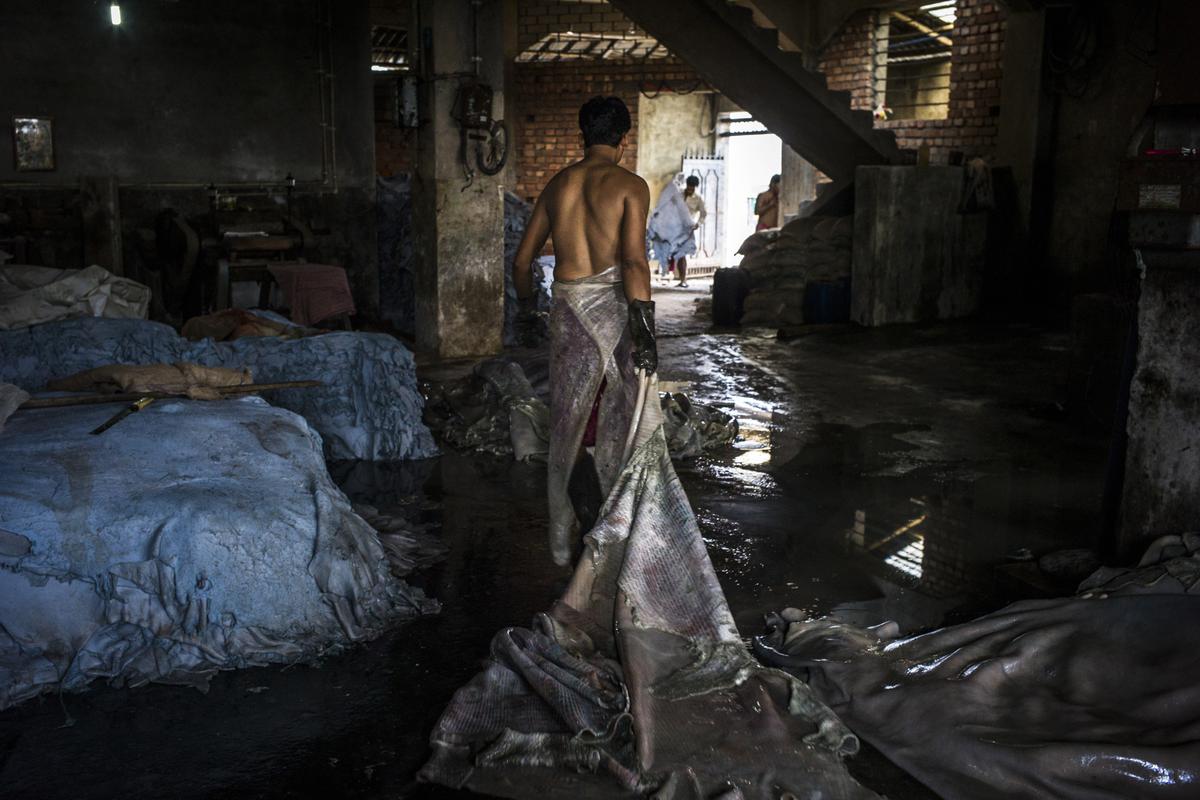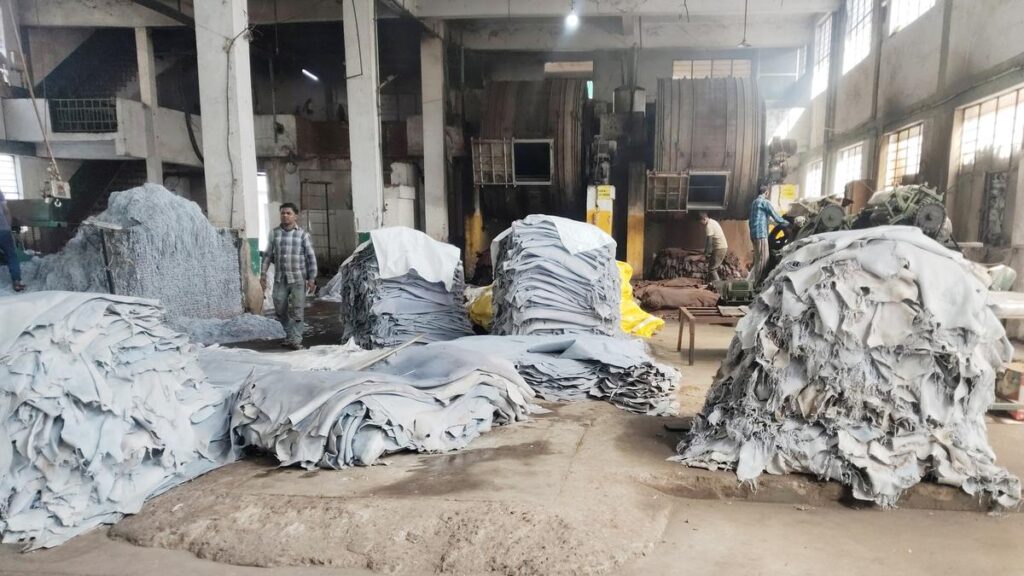Standing at the entrance of his two-room, single-storey house that has a leaking roof, fissured walls, and damaged floors, Ram Nath Yadav, 54, laughs sardonically. His neighbour, Vakil Ahmed, in his late 50s, has just told him that the Central government is planning to establish a mega leather cluster where 175 tanneries will be established or relocated in Ramaipur, Kanpur.
Here, about 12 kilometres from Kanpur’s city centre, spread across 2,000 acres, Uttar Pradesh will see a regeneration of an industry that flourished after the 1857 War of Independence.
It is March 8, and Ahmed, a teacher in a privately run school, had read a local Hindi daily report that quoted a letter from the Union Commerce and Industry Minister to Kanpur MP Ramesh Awasthi. The Centre had asked for a Detailed Project Report on the cluster, the report had stated. Ahmed is sympathetic to Yadav because his own father was a tannery worker.
Yadav, a second-generation tannery worker who lives in Afeem Kothi locality in Kanpur, says, “My job is increasingly becoming irregular. Things have got worse over the last eight years. I hope with this cluster, the cost of tannery waste treatment will decrease, and pollution curbs will ease.” He wonders whether this will revive the industry and the livelihood that so many depend on.
Last year, he barely earned ₹60,000, one-third of what he earned a decade ago. “The salary plummeted when I needed it the most,” he says, adding that he needs money to marry off both his daughters.
Now, the National Green Tribunal (NGT) is hearing a case that raises grave concerns about environmental pollution in the districts of Kanpur Nagar, Kanpur Dehat, and Fatehpur mainly due to leather tannery effluents flowing into the Ganga and the soil.
Heavy metals, such as chromium and mercury, have also led to a public health crisis.
Health and earth problems
Kanpur, known as the ‘Leather City of India’, has over 200 active tanneries spread across a 15-kilometre area. Tanning is the process in leather-making when the hide, already taken from an animal, is processed to remove hair and tissue, and built into a resilient material. Tanning derives its name from tannic, the acidic agent that helps cure the hide.
The tannery industry in Kanpur was fuelled by the demand for military leather goods from the British army, access to water from the Ganga, a plentiful labour force, raw materials, and extensive undeveloped land.
The NGT, the statutory body in India that deals with cases related to environmental protection, in November 2024, directed the U.P. government to conduct health camps in the most severely affected areas, including Rakhi Mandi and Afeem Kothi, in Kanpur Nagar district. The camps revealed high levels of mercury and chromium in the residents’ blood samples. Similar health camps organised in Kanpur Dehat and Fatehpur districts led to the identification of widespread health issues, including respiratory ailments, neurological disorders, behavioural changes, and skin conditions, among residents.

A worker at a tannery in the Bantala area of Kolkata, West Bengal.
| Photo Credit:
Sanjit Das
The affidavit of the District Magistrate, Kanpur Nagar, submitted to the NGT states that in various camps conducted in Punki and Jajmau industrial areas, among others, people were found suffering from an array of problems, such as liver disease and respiratory issues. The amicus curiae (adviser to a court) submitted that during her interaction with the patients, she had also found a paucity of doctors in the area and a lack of testing infrastructure to check for the presence of heavy metals in the bloodstream.
Rajnish Mishra, 48, who lives in Kanpur and is a medical representative, says, “I have developed asthma over the years, and my wife has chronic obstructive pulmonary disease (COPD). Something must be done to improve our situation. This area has become hell.”
It’s not just physical health, but also financial health that has deteriorated. “There was a time when Kanpur and adjoining parts had over 600 tanneries, employing more than 1 lakh workers. However, it declined since 2017 when the Uttar Pradesh Pollution Control Board (UPPCB) mandated that tanneries reduce their infrastructure by half, or face an environmental compensation penalty of ₹12,500 per day,” says Shahid, in his 50s, who owns a tannery business in partnership. The year before, they had been hit overnight by demonetisation. Now, he says, they operate the factory for 15 days a month at half the capacity. From processing 100 hides daily, they have come down to 50.
After 2020, the cost of treating tannery waste surged from ₹2 per hide to more than ₹15 per hide, as tanneries were asked to bear the expenses associated with treating effluents sent to the common effluent treatment plant managed by the Water Department, say tannery owners.
Currently, the processing cost per hide has risen to approximately ₹100, and tanneries are operating at only 25% of their capacity, with the employees facing pay cuts. The prolonged shutdown of tanneries due to pollution-related issues and festivals like the Kumbh and Magh Melas have contributed to the crisis. In fact, over the past eight years, many tanneries have been temporarily closed at least nine times, with periods ranging from a few weeks to even over a year.
Kanpur processes hides mainly from U.P. and some from Rajasthan and Madhya Pradesh. However, with a ban on cow slaughter in these States, and the fear of cow vigilantes, cattle hides are few.Cattle, being large animals, are in highest demand in the international market.
Yadav says hides are taken off the animal as soon as it is killed. After that, they are carefully salted at slaughterhouses to prevent the growth of bacteria. Before being sold to tanneries, the hides are salted to remove 55% of their water content and then dried for three to six days.
Ahmed remembers the process from his childhood and youth in graphic detail, when he would go with his father to witness it: “Raw hides are first preserved and desalted in the tannery. During the first factory inspection, hair from the hide is pulled to check for bacterial damage. Non-usable portions are removed, and hides are soaked to remove blood, grime, and salt.” He describes a machine called the salt shaker, through which hides were put to remove the salt.
Tannery owners and workers say that the increasing challenges in the industry are prompting many leather tanning business owners to leave Kanpur. “Small and medium-sized players are shifting to West Bengal, where they are renting or purchasing tanneries. Many have established collaborations with companies in Vietnam and Europe to import hide and produce finished leather,” adds another owner.
Response and hope
In November last year, the NGT issued detailed directions to the government to submit time-bound action plans by March 7, 2025, for several sectors, including health, drainage and effluent treatment, river rejuvenation, and soil and groundwater remediation. The government, however, did not submit a progress report.
Trade union activists hold factory owners responsible for environmental pollution and decline in employment avenues. They say employers benefit from taking on workers for short durations, so that management can avoid bearing responsibilities such as Provident Fund, gratuity, paid leave, and other benefits of the organised sector.
“Across tanneries and allied industries (like footwear and finished leather), there is no implementation of labour laws,” says Chandershekhar, the All India Trade Union Congress general secretary (U.P.). He says tannery owners don’t comply with pollution rules either, with the installed effluent processing units often being dysfunctional or lacking the required capacity to treat the waste.
In October 2019, for instance, the UPPCB ordered tanneries in Kanpur to shut after a report by the Ganga monitoring wing of the NGT found shortcomings in 126 tanneries permitted to run at 50% capacity. “The effluents from tanneries located in the Jajmau industrial area were being released into the river,” the UPPCB had observed at the time.
Critics connect the industry’s decline with the Hindutva ideology of the BJP that is in government at the Centre and the State.
“If you take a deep dive into the main stakeholders of the trade, the majority of the workers and tannery owners are Muslims. An affluent class emerged in the last century in Kanpur because of the tannery industry,” says Shahnawaz Alam, national secretary, Congress. In 2021-2022, he had initiated a campaign among owners and workers in Kanpur and Lucknow to revive tanneries. He adds that if the government wanted to check pollution, it should have made alternative arrangements instead of “systematically finishing the industry”.
The U.P. government says it is drafting a new leather and footwear policy to boost exports. The policy aims to provide financial support, technological upgradation, and export subsidies to manufacturers and exporters, and is likely to focus on supporting design capacity, component manufacturing, and machinery required for leather footwear.
Awasthi, the Kanpur MP, who is at the forefront of pushing for a dedicated leather cluster, says the space will significantly lower pollution and help the industry flourish. “The mega leather cluster will be set up in an organised, systematic way,” he says, hoping that the process will be kick-started this year.
Hope is what keeps Yadav in the profession. “I will wait for a year. If the situation doesn’t get better, I will shift to working as an auto driver. Maybe I will buy a CNG vehicle,” he says, adding that two of his former colleagues who changed trade in 2020 earn over ₹20,000 a month.
Edited by Sunalini Mathew
Published – April 20, 2025 07:17 pm IST
Source:https://www.thehindu.com/news/national/uttar-pradesh/exfoliating-dead-skin/article69465803.ece

